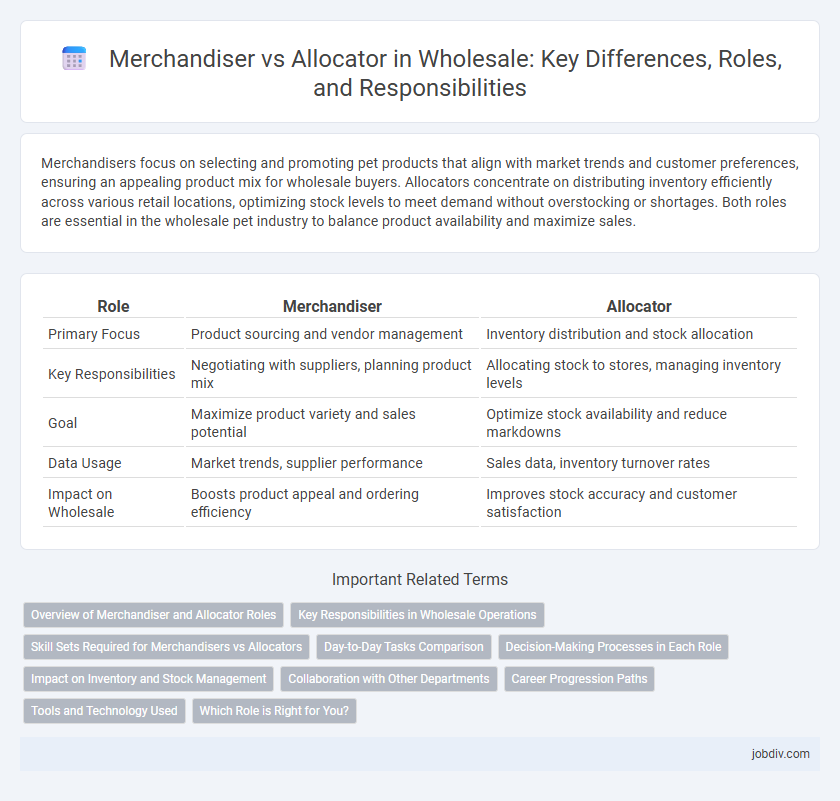Merchandisers focus on selecting and promoting pet products that align with market trends and customer preferences, ensuring an appealing product mix for wholesale buyers. Allocators concentrate on distributing inventory efficiently across various retail locations, optimizing stock levels to meet demand without overstocking or shortages. Both roles are essential in the wholesale pet industry to balance product availability and maximize sales.
Table of Comparison
| Role | Merchandiser | Allocator |
|---|---|---|
| Primary Focus | Product sourcing and vendor management | Inventory distribution and stock allocation |
| Key Responsibilities | Negotiating with suppliers, planning product mix | Allocating stock to stores, managing inventory levels |
| Goal | Maximize product variety and sales potential | Optimize stock availability and reduce markdowns |
| Data Usage | Market trends, supplier performance | Sales data, inventory turnover rates |
| Impact on Wholesale | Boosts product appeal and ordering efficiency | Improves stock accuracy and customer satisfaction |
Overview of Merchandiser and Allocator Roles
Merchandisers drive product selection, pricing strategies, and inventory planning to maximize sales within wholesale channels. Allocators focus on distributing stock efficiently to various locations by analyzing sales data and demand patterns, ensuring optimal inventory levels. Both roles collaborate closely to balance supply and demand, enhancing overall profitability and customer satisfaction.
Key Responsibilities in Wholesale Operations
Merchandisers in wholesale focus on product selection, pricing, and inventory management to ensure the right merchandise meets market demand. Allocators manage the distribution of products across multiple retail locations, optimizing stock levels to maximize sales and reduce markdowns. Both roles collaborate to balance inventory flow, enhance sales performance, and support overall wholesale operations.
Skill Sets Required for Merchandisers vs Allocators
Merchandisers require strong analytical skills, proficiency in sales forecasting, and a deep understanding of market trends to drive product assortment and pricing strategies effectively. Allocators must excel in inventory management, demand planning, and distribution logistics to optimize stock levels across multiple retail locations. Both roles demand excellent communication abilities and a collaborative mindset to align merchandising plans with supply chain execution.
Day-to-Day Tasks Comparison
Merchandisers analyze market trends and customer demand to plan product assortments, negotiate with suppliers, and coordinate product launches to optimize inventory levels. Allocators focus on distributing inventory across stores or regions, monitoring stock performance, and adjusting allocations to maximize sales and minimize markdowns. Both roles require strong data analysis skills, but merchandisers emphasize product selection while allocators prioritize inventory placement and flow.
Decision-Making Processes in Each Role
Merchandisers analyze market trends and sales data to decide which products to purchase and promote, focusing on maximizing product assortment and inventory turnover. Allocators use sales performance and inventory levels to strategically distribute merchandise across stores, ensuring optimal stock balance and regional demand fulfillment. Both roles rely on data-driven decision-making but vary in scope, with merchandisers focusing on product selection and allocators on inventory distribution.
Impact on Inventory and Stock Management
Merchandisers drive demand forecasting and product selection to optimize inventory turnover rates, ensuring stock availability aligns with market trends. Allocators focus on distributing inventory efficiently across multiple locations, balancing stock levels to prevent overstock and stockouts. Effective collaboration between merchandisers and allocators enhances overall inventory accuracy and reduces carrying costs in wholesale operations.
Collaboration with Other Departments
Merchandisers collaborate closely with design, marketing, and sales teams to ensure product assortments meet market demand and brand strategy. Allocators work alongside inventory management, logistics, and retail operations to optimize stock distribution and maximize sales performance across locations. Effective collaboration between merchandisers and allocators enhances supply chain efficiency and boosts overall wholesale profitability.
Career Progression Paths
A merchandiser typically begins by managing product assortment, pricing, and promotion strategies to drive sales, progressing to senior roles such as Merchandising Manager or Category Director. An allocator focuses on inventory distribution across retail locations, advancing towards positions like Allocation Manager or Inventory Planning Director. Both career paths emphasize analytical skills and market trends but diverge in focus; merchandisers prioritize product selection and customer demand, while allocators specialize in stock optimization and supply chain efficiency.
Tools and Technology Used
Merchandisers primarily utilize demand forecasting software, point-of-sale data analytics, and inventory management systems to optimize product selection and placement. Allocators rely heavily on allocation management tools, replenishment software, and distribution planning technology to ensure the right quantity of merchandise reaches each retail location. Both roles increasingly adopt AI-driven platforms and real-time data integration to enhance accuracy and responsiveness in wholesale operations.
Which Role is Right for You?
Choosing between a merchandiser and an allocator depends on your strengths and career goals in wholesale. Merchandisers excel at product trend analysis, inventory forecasting, and visual presentation to maximize sales and customer engagement. Allocators thrive in data-driven environments, focusing on optimizing stock distribution across multiple locations to enhance supply chain efficiency and reduce markdowns.
Merchandiser vs Allocator Infographic

 jobdiv.com
jobdiv.com